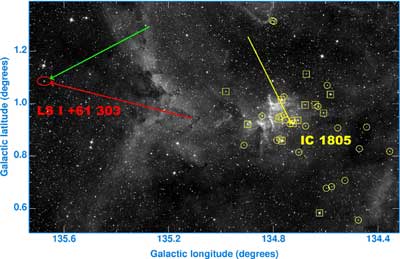Astronomers assigned a pair of stars to the cluster in which they were born

The microquasar (circled in red) and the stars in the cluster (in yellow). The green arrow symbolizes the movement of the microquasar and the yellow arrow symbolizes the movement of the stars in the cluster. The image was taken in the visible light range. Credit: NRAO
With the help of telescopes that have studied over long periods of time, and sophisticated information systems; Astronomers from the National Scientific Organization concluded that a pair of young stars - which today [apparently to us] form a double system between them and an active micro-quasar [see the concept explanation later in the article], were blown out of the cluster where they were formed about 1.7 million years ago in a supernova explosion. This is the first time astronomers have been able to attribute a pair of fast-moving stars to a specific star cluster from which it was ejected.
The scientists analyzed many observations of the microquasar and concluded that it was moving from the cluster IC 1805 [located in the Cassiopeia group] at a speed of 27.3 km per second.
A micro-quasar is a pair of stars, while one of them is a dense neutron star or black hole, and the other star creates a disk of material around it that emits X-rays and jets of subatomic materials, all this: close to the speed of light.
"In this case, both the microquasar and the cluster are 7,500 light-years away from Earth, the characteristics of the normal star in the microquasar are the same as those of the stars in the cluster, and therefore we believe that they are related," said Felix Miraval, an astrophysicist at the Institute of Astronomy and astrophysics in Argentina and the French Atomic Energy Commission. Mirabel worked with Irfuen Rodriguez of the Federal University of Rio Grande do Sul in Brazil, and Quinzong Liu of the Purple Mountain Observatory in Nanjing, China. The astronomers reported their first results in the August magazine of "Astronomy & Astrophysics".
Many neutron stars were found to be moving rapidly across the sky, leading scientists to conclude that supernova explosions are asymmetric, as they "kick" the star.
The motion of that microquasar pulled it about 130 light-years from the cluster IC 1805.
The same microquasar contains a neutron star or black hole twice the mass of our Sun, and orbits an ordinary star about fourteen times the mass of our Sun.
According to the researchers, that neutron star black hole used to be much larger and more massive than its partner, about 60 times, but collapsed and lost 90% of its mass even before the supernova scenario.
On the other hand, the same star could have formed only 10 million years ago, in any case it was 15-20 times bigger than our sun.
"Studying this system, and hopefully others as well - will help us understand the development of stars and their systems before they collapse into a supernova, as well as - the physics in the supernova," Miraval said.
Translation and editing:
Amit Oren
